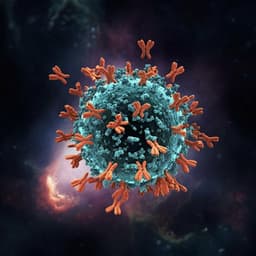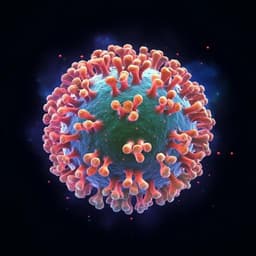
Medicine and Health
A comprehensive synthetic library of poly-N-acetyl glucosamines enabled vaccine against lethal challenges of *Staphylococcus aureus*
Z. Tan, W. Yang, et al.
This exciting study by Zibin Tan and colleagues synthesized a library of 32 PNAG pentasaccharides, identifying unique sequences for vaccine development against Staphylococcus aureus. Their findings show remarkable protection against MRSA in mice, highlighting the potential of this library for future vaccine innovation.
~3 min • Beginner • English
Introduction
Bacterial infections remain a major global health threat, exacerbated by antimicrobial resistance and the emergence of multidrug-resistant strains such as methicillin-resistant Staphylococcus aureus (MRSA). Despite successful vaccines against certain pathogens, there are no approved vaccines for many deadly organisms including S. aureus, which caused over 300,000 infections and 20,000 deaths via bloodstream infections in the USA in 2017. A central challenge in vaccine development is selecting an effective antigen. The cell wall and biofilm of S. aureus and numerous other microbes contain the polysaccharide poly-β-(1→6)-N-acetylglucosamine (PNAG), a virulence factor aiding immune evasion and expressed across diverse pathogens. PNAG’s structural heterogeneity arises from variable degrees and positions of N-acetylation versus free amines on glucosamine residues, and the precise structures on bacteria are not fully defined. Prior studies showed that fully deacetylated PNAG oligosaccharide conjugates (e.g., to tetanus toxoid, TT) can induce protective immunity, while fully acetylated counterparts are poorly protective. However, it is unknown which specific PNAG patterns (number and positions of free amines vs N-acetyl groups) constitute optimal protective epitopes. This study addresses that knowledge gap by synthesizing a comprehensive PNAG pentasaccharide library to decode epitope preferences and guide vaccine design, using a potent mutant bacteriophage Qβ (mQβ) carrier to elicit strong anti-PNAG responses and test protection against S. aureus, including MRSA.
Literature Review
Previous work established PNAG as a broadly expressed microbial polysaccharide and a promising vaccine target. PNAG oligosaccharides (penta- and nonasaccharides) with either fully free amines (deacetylated) or fully acetylated forms have been synthesized and conjugated to carriers such as tetanus toxoid (TT). Animal studies showed TT conjugates with fully deacetylated PNAG induce protective immunity (opsonic killing and in vivo protection), whereas fully acetylated PNAG conjugates did not. Multiple synthetic routes for PNAG fragments have been reported, but an efficient, general method to construct a comprehensive set with systematically varied acetylation patterns was lacking. Monoclonal antibody F598, isolated from a human recovering from S. aureus infection, binds PNAG and protects in mice, implicating specific PNAG acetylation patterns as critical epitopes. The antigen density on virus-like particles such as Qβ affects B-cell activation, motivating the use of a high-density mQβ carrier for carbohydrate vaccines. These observations informed the need for a systematically varied PNAG library to identify protective epitopes and construct improved conjugate vaccines.
Methodology
- Synthesis: Developed a divergent synthesis strategy to generate 32 PNAG pentasaccharides (PNAG0–PNAG31) encompassing all combinations of free amine (GlcN) and N-acetyl (GlcNAc) across five residues (A–E). Two linchpin pentasaccharide intermediates (1 and 2) were designed with orthogonal N-protecting groups (Boc, Alloc, Troc, Fmoc) on units A–D and either N-acetyl or N-trifluoroacetyl on unit E. Orthogonal deprotections (90% aq TFA, Pd(PPh3)4/PhSiH3, Zn/AcOH, 20% piperidine/DMF), followed by selective acetylations and global deacylation (20% hydrazine in MeOH), enabled divergent access to all 32 sequences. Each pentasaccharide bears a disulfide-terminated linker at the reducing end for chemoselective conjugation.
- Conjugation: PNAG glycans were conjugated to mutant bacteriophage Qβ (mQβ A38K/A40C/D102C) via SBAP linker chemistry (amine-reactive NHS ester and thiol-reactive bromoacetamide) using glycan disulfide reduction to introduce free thiols, yielding ~250 glycans per mQβ particle by MALDI-TOF MS. A TTHC-PNAG0 conjugate (recombinant tetanus toxoid heavy chain) was also prepared for head-to-head comparison. BSA-PNAG conjugates were used for ELISAs and glycan microarrays.
- Immunizations: Mice (C57BL/6 and CD1) received subcutaneous vaccinations on days 0, 14, 28 with MPLA adjuvant and 8 nmol glycan dose per injection. Rabbits (New Zealand white) were immunized with PNAG0, PNAG10, or PNAG26 mQβ conjugates with CFA/IFA prime-boost schedule.
- Epitope profiling: A glycan microarray displaying the 32 PNAG-BSA conjugates probed binding of anti-PNAG mAb F598. A preference index for acetylation at each site (A–E) was calculated from relative fluorescence signals to evaluate site-specific preferences.
- Functional assays: ELISA quantified IgG titers to glycan-BSA and to native PNAG polysaccharide purified from Acinetobacter baumannii. Complement deposition assays measured C1q deposition onto PNAG. Opsonophagocytic killing (OPK) assays used HL-60 phagocytes, complement, and S. aureus ATCC29213.
- In vivo protection: Active protection—mice immunized with mQβ-PNAG0 versus TTHC-PNAG0; challenged intravenously with S. aureus ATCC29213 (2×10^7 cfu). Passive protection—mice received 1:800 diluted rabbit antisera (PNAG0, PNAG10, or PNAG26), alone or combined, followed by lethal S. aureus challenge (2×10^6 cfu). MRSA passive model used clinical strain 1058 with 1:800 diluted sera. Survival assessed by logrank tests; kidney bacterial burden quantified.
- Microbiome: 16S rRNA sequencing (V3–V4) of fecal samples pre- and post-immunization with mQβ-PNAG26 to assess gut microbiome impact.
Key Findings
- Comprehensive PNAG library: Successfully synthesized all 32 PNAG pentasaccharides representing every combination of free amine vs N-acetyl across five residues, using two linchpin intermediates and orthogonal deprotection.
- mAb epitope code: Anti-PNAG mAb F598 bound preferentially to highly acetylated PNAG sequences; minimal binding to PNAG0 or glycans with only one acetyl group. Site-specific analysis showed strong preference for N-acetylation at unit B (preference index P≈0.91); A, C, and E showed moderate preferences (P≈0.31–0.54). Structural rationale from PDB 6be4 indicates deep pocket interactions with NHAc at B and D.
- Epitope-guided antigen selection: PNAG10 (01010) and PNAG26 (11010), both containing NHAc at B and D, were selected as vaccine antigens in addition to PNAG0.
- Immunogenicity: High-density mQβ-PNAG conjugates elicited robust anti-PNAG IgG in mice and rabbits. In mice, GMTs to the immunizing antigens on day 35 were high (e.g., PNAG10: ~191,141; PNAG26: ~227,064 ELISA units). Admixture of unconjugated PNAG with mQβ failed to induce IgG, underscoring the necessity of covalent conjugation and high antigen density (~250 copies/particle).
- Native PNAG recognition: Rabbit antisera to mQβ-PNAG10 and mQβ-PNAG26 showed strong binding to purified native PNAG; mQβ-PNAG26 antisera had the highest titer (~1,584,983 ELISA units). By contrast, sera from 5GlcNH2-TT immunized rabbits and normal human sera had low titers (~501 and ~631 ELISA units, respectively).
- Functional activity: Complement deposition (C1q) onto PNAG was significantly higher for mQβ-PNAG10 and mQβ-PNAG26 antisera than for mQβ-PNAG0 and 5GlcNH2-TT. OPK EC50 titers against S. aureus were higher for PNAG26 (EC50 ~2534) and PNAG10 (EC50 ~3045) than PNAG0 (EC50 ~1345).
- Active protection: In a lethal S. aureus bacteremia model, mQβ-PNAG0 vaccination provided 95% survival and significantly outperformed TTHC-PNAG0 (p=0.0154, logrank). Kidney bacterial burden was significantly reduced; contingency analysis showed fewer infected kidneys in mQβ-PNAG0 vs TTHC-PNAG0 (Fisher’s exact p=0.0436; relative risk 0.68, 95% CI 0.45–0.93).
- Passive protection: With 1:800 diluted rabbit sera, survival was 60% (PNAG26), 50% (PNAG10), and 30% (PNAG0). Combining PNAG26+PNAG0 sera (each at 1:1600; total equivalent to 1:800) yielded 100% survival and no detectable kidney bacteria.
- MRSA efficacy: Against MRSA strain 1058, passive transfer of PNAG26 antisera protected 90% of mice, versus 40% with PNAG0 antisera, and yielded the lowest kidney bacterial loads.
- Safety/microbiome: mQβ-PNAG vaccinations caused no observed adverse effects and did not significantly alter the gut microbiome composition in mice by 16S rRNA profiling.
Discussion
The study addresses a core challenge in PNAG-based vaccine design: identifying protective epitopes within a structurally heterogeneous polysaccharide. By constructing a complete PNAG pentasaccharide library and probing binding with a protective human mAb (F598), the work defines an acetylation pattern code, highlighting the critical role of N-acetylation at residue B (and enhanced binding with D). This epitope insight informed selection of PNAG10 and PNAG26, which, when displayed at high density on mQβ, elicited potent IgG responses that effectively fix complement and mediate opsonophagocytic killing. In vivo, mQβ markedly outperformed a TT-derived carrier in active protection, and passive transfer of antisera demonstrated robust protection against lethal S. aureus, including MRSA, with broadened efficacy when combining antisera recognizing different PNAG patterns. These findings reinforce the importance of antigen density and precise acetylation positioning for functional anti-PNAG immunity and demonstrate that rational epitope-guided design can yield highly protective carbohydrate conjugate vaccines.
Conclusion
This work delivers: (1) an efficient divergent strategy to synthesize a comprehensive set of 32 PNAG pentasaccharides; (2) an epitope map for anti-PNAG mAb F598 revealing a strong preference for N-acetylation at residue B (and benefit at D); and (3) highly immunogenic, functional mQβ-based PNAG vaccines. Epitope-guided antigens PNAG10 and PNAG26 on mQβ elicited high-titer, complement-fixing, opsonic antibodies that conferred near-complete protection in active models and strong protection in passive models against S. aureus and MRSA, with no detectable microbiome disruption. These results provide a blueprint for next-generation PNAG vaccines and suggest combining antigens/antisera recognizing complementary PNAG patterns may broaden coverage. Future directions include testing multivalent PNAG constructs, assessing durability and breadth across additional pathogens expressing PNAG, optimization for clinical translation, and structural studies to further refine epitope features.
Limitations
- Structural scope: The library uses pentasaccharides; while informative, native PNAG is a polysaccharide with varied chain lengths and acetylation microheterogeneity. Epitope mapping may not capture all conformations or higher-order structural effects in vivo.
- Translational models: Protection was demonstrated in mice with intravenous bacteremia challenges and passive transfer models; these may not fully recapitulate diverse human infection routes or immunity. Rabbit group sizes were small (n=2), limiting statistical power for some immunogenicity readouts.
- Antigen diversity: Only three PNAG patterns (PNAG0, PNAG10, PNAG26) were advanced into vaccine studies; additional patterns might further enhance breadth/efficacy.
- Carrier-specific effects: mQβ provided superior immunogenicity versus TTHC; results may be carrier- and density-dependent, and scalability/manufacturability considerations for mQβ need evaluation.
- Pathogen heterogeneity: The precise PNAG acetylation patterns on different clinical isolates remain incompletely defined, which may influence vaccine breadth; although MRSA protection was demonstrated, broader strain coverage requires further testing.
Related Publications
Explore these studies to deepen your understanding of the subject.







